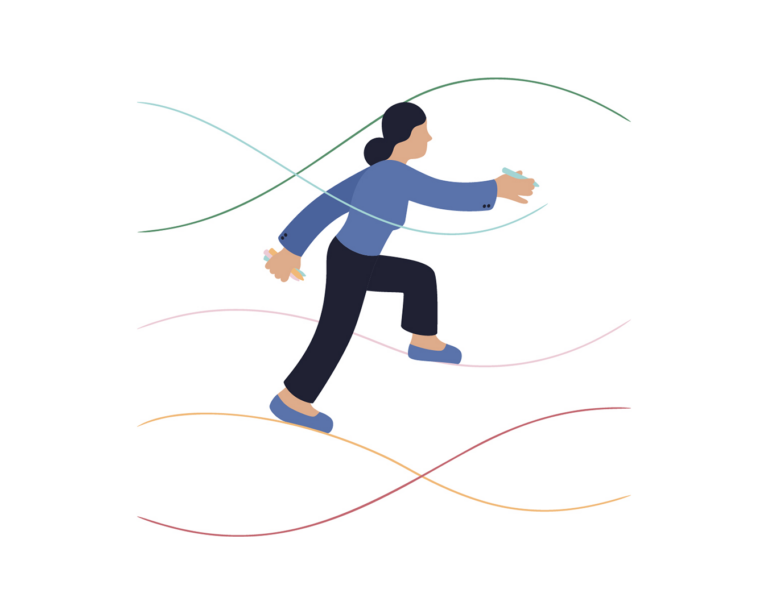Art therapy's role in strengthening parent–baby connection (part 1)
Perspectives
Our perspectives articles are a regular series dedicated to sharing the knowledge and viewpoints of those with a unique or specialist understanding of art therapy.
In this issue, Julia Ruppert interviews Diane Bruce, a highly experienced art psychotherapist specialising in maternal, perinatal and parent–infant mental health. Her work integrates psychodynamic, systemic and attachment-based approaches to help families navigate trauma, build resilience and strengthen the bonds between parents and their babies.

Diane, how did your journey into art therapy – particularly within perinatal mental health – begin?
My background is in education involving art and design, where I taught anthropometrics, pattern cutting and fashion design. Then as part of a master’s in fine art, I found myself exploring themes around the female body. I became fascinated by postural changes, as we age and in the pregnant body. Over time, that physical curiosity developed into a more psychological and emotional one. I became a parent myself and then found myself wanting to integrate creativity and therapeutic practice. That’s when I decided to train as an art psychotherapist.
During my training, my final placement was with the North-East London Foundation Trust (NELFT) in adult psychology, supervised by principal art psychotherapist Alexandra Garriock. She introduced me to Dr Amanda Jones, Principal Perinatal Consultant, who co-pioneered the development of the Perinatal Parent Infant Mental Health Service at NELFT.
Amanda was incredibly open to integrating creative arts into parent–infant work. I was fortunate to first secure an honorary placement which eventually turned into a paid role at NELFT. I was sponsored to complete a postgraduate diploma in Parent–Infant Mental Health at the Anna Freud Centre, which included video intervention and infant observation. All of this secured a solid introduction to my art therapy practice in perinatal parent–infant work.

In your writing, you highlight the intergenerational effects of attachment and bonding. How do you see art therapy – and the tactility of materials in particular – playing a role in fostering early parent–infant connection?
The sensory qualities of the arts, art materials and their links with parent–infant work are immense. Pregnancy is such a full-body experience with intense and transitory hormonal changes. Women and pregnant people who may be afraid of what is happening during pregnancy can, using art materials, be helped to understand the strangeness of these changes. When someone is pregnant, they may, for instance, be able to connect to their unborn baby through the sensory qualities of art materials. Preparing for birth can be a highly anxious time – touching art materials can help some parents feel more relaxed about labouring and meeting their baby for the first time. A new baby is like a live electric wire, highly sensitive to their new ‘outside’ surroundings. They are particularly sensitive to touch and being touched. Art materials can help increase a new parent’s sensitivity to how touch might feel for their baby.
Babies are used to being on the inside – cushioned by warm fluid, muffled sound and movement. Suddenly they’re outside, exposed to bright light, strong smells and the busyness of the world around them – it’s a highly charged situation. When a mother engages with tactile materials, it helps her attune to those sensory shifts from the baby’s viewpoint. That’s where art therapy offers something unique – it’s not just about insight, it’s about deep and innate feelings that are difficult to describe using words.
Touch is core to attachment. Parents who are struggling with bonding issues can be helped to connect to their baby through their sensory experiences with art materials. If they’re using art materials, they’re in touch with something tactile, it might take them back to their own (pre-verbal) infant experiences of touch and the powerful feelings they may themselves have experienced. Artmaking helps us tap into primitive parts of the mind that connect us to memories which are not always consciously accessible. If safely contained in the presence of a therapist, mother and baby can practise a shared, healing experience. The more a parent can understand their own ‘sensory history’ and what’s happened to them emotionally,—the more they may be able to relate to their baby’s experience; and if they are ready to engage in therapy, they may be helped to repair ruptures in their bonding experience that is live in the therapy room.
When a mother hears, ‘Look how your baby turns to you for comfort’, it can boost her confidence and make her want to recreate that connection again and again.

How is the video documentation used in your work?
If you’re lucky enough to have the clinical time and the written permission to film parents and babies together, I think video intervention can help in two key ways.
First, it’s incredibly useful in supervision. You can repeatedly look closely at the detail of what might be happening between a parent and baby. When you slow down a video of a parent and baby’s interaction, you might notice small but powerful moments – a mother reaching out to touch her baby, then immediately jolting back for instance. The meaning of that moment can be explored and analysed. If the parent has been artmaking too, this adds another layer to the reflection.
The second way is how we can share recordings with a parent to empower them. What we have seen on video in supervision may not be what we would want to directly point out to a parent. When sharing with the parent, we frame the interaction as positively as possible. We focus on encouragement and on empowerment. It is important to validate confident moments in the video that support the good interactions the pair are having, focusing on how these moments can be increased. You might say: ‘Look how your baby is smiling at you’, or ‘Did you see how he/she handed you that toy?’ Even if it’s just a split second of positivity, that can be enough to help the mother feel good. A parent often needs something positive to hold on to – something that says, ‘you’re doing something – actually a lot – right’.
As professionals, with knowledge of attachment theory, we might see more – how far a mother has come, what she’s bringing from her own experience of being parented, and what might help her and her baby going forward. But our job is to translate that insight in a way that supports and uplifts. When a mother hears, ‘Look how your baby turns to you for comfort’, it can boost her confidence and make her want to recreate that connection again and again. This builds positive and affirmative momentum into their attunement and thus aids the development of their relationship.
As the therapist, you’re not hijacking their narrative, you are validating and gently illuminating it

I’m struck by how deeply noticing is linked to mental health and wellbeing. In a way, you’re modelling those skills – this focus on the positive, on what’s working – and that’s become such an important shift. We’re moving away from ‘what’s wrong’ towards ‘what’s strong’, and that can be a real springboard.
Absolutely, yes – completely agree. The patient–therapist experience is becoming a partnership in confronting trauma (in this case relational trauma) and moving towards recovery. I think this is so important, especially in the intergenerational dynamics of a parent–infant relationship. You’re creating space in the mind of the woman/mother to feel empowered, to feel that it’s their story. As the therapist, you’re not hijacking their narrative, you are validating and gently illuminating it, helping them to create their own formulation of what has happened to them, helping them feel in control about what they’ve gone through and what they’re now doing right, and co-care planning the best treatment and way forward for them and their baby.
Another powerful aspect of video intervention is the relational trust it can build. When you give the parent the camera – or nowadays we often use the parents’ phones –where they own the video, they can watch it back themselves. What you’re pointing out are the positive moments. That process, of holding the video and even watching through the lens of how the therapist interacts with their baby, helps them to see things objectively, from the outside-in. It’s not about judgment; it’s about empowerment. I’ve repeatedly seen how helpful this can be.
The person keeping the video makes me think of transitional objects – it’s something they can take away, something to hold onto, literally and emotionally.
Yes, exactly, it certainly does have similarities with the role of a transitional object. What’s captured in the video can include more than just the interaction, it may be the art object itself. So, when the mother revisits that video, she’s reconnecting not just to the moment, but with all that is held emotionally and creatively.
Read part 2
You can continue reading about Diane’s work in part 2 of this interview.
An introduction to perinatal art therapy

